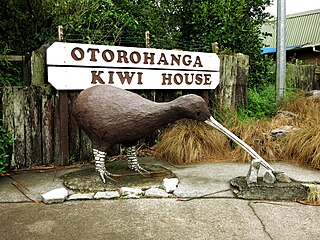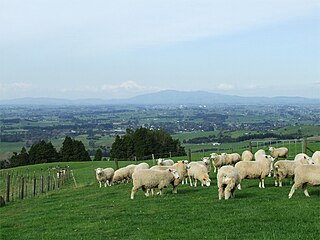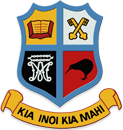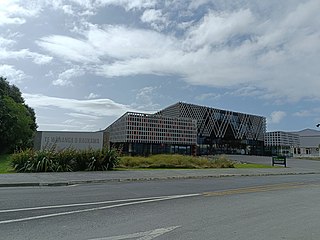In the education system of New Zealand, a wānanga is a publicly-owned tertiary institution or Māori university that provides education in a Māori cultural context. Section 162 of the New Zealand Education Act of 1989 specifies that wānanga resemble mainstream universities in many ways but expects them to be:

Te Awamutu is a town in the Waikato region in the North Island of New Zealand. It is the council seat of the Waipa District and serves as a service town for the farming communities which surround it. Te Awamutu is located some 30 kilometres (19 mi) south of Hamilton on State Highway 3, one of the two main routes south from Auckland and Hamilton.

Ōtorohanga is a north King Country town in the Waikato region in the North Island of New Zealand. It is located 53 kilometres (33 mi) south of Hamilton and 18 kilometres (11 mi) north of Te Kūiti, on the Waipā River. It is a service town for the surrounding dairy-farming district. It is recognised as the "gateway" to the Waitomo Caves and as the "Kiwiana Town" of New Zealand. Until 2007, Ōtorohanga held a yearly 'Kiwiana Festival.'

Martinborough is a town in the South Wairarapa District, in the Wellington region of New Zealand. It is 65 kilometres east of Wellington and 35 kilometres south-west of Masterton. The town has a resident population of 2,050.

Pirongia is a small town in the Waipa District of the Waikato region of New Zealand's North Island. It is 12 kilometres to the west of Te Awamutu, on the banks of the Waipā River, close to the foot of the 962 metre Mount Pirongia, which lies in Pirongia Forest Park to the west of the town.
NorthTec is a tertiary education provider in northern New Zealand, with its main campus in Raumanga, Whangārei. NorthTec provides programmes ranging from foundation, certificate, diploma and degree levels. The degrees are nationally monitored and so can lead to postgraduate study at universities and other organisations. NorthTec works closely with local and national industries.
Rongo Herehere Wetere of Ngāti Maniapoto descent, founder of the Te Wananga o Aotearoa (TWoA) tertiary institution in New Zealand and an Officer of the Order of New Zealand of Merit. He was previously chair of the Māori Employment and Training Commission. He was the chief executive of the Te Wananga o Aotearoa tertiary institution but resigned from his post in 2005 following government pressure. A subsequent report by the Office of the Auditor-General found that the finances of the TWoA were in order despite the university being Indigenous.

Purerua Peninsula is a peninsula on the northwest side of the Bay of Islands in Northland, New Zealand. Te Puna Inlet lies to the south of the peninsula. Communities on the peninsula are Purerua, Te Tii and Taronui Bay. Rangihoua Bay is at the southern end of the peninsula.
Ngāti Whare is a Māori iwi of New Zealand. It is part of a group of tribes participating in the "treelords" Treaty of Waitangi settlement with the New Zealand government involving Central North Island forestry land and cash.

Kura kaupapa Māori are Māori-language immersion schools in New Zealand, where the philosophy and practice reflect Māori cultural values with the aim of revitalising Māori language, knowledge and culture. Kura kaupapa Māori are established under the Education Act (1989). The term kaupapa Māori is used by Māori to mean any particular plan of action created by Māori to express Māori aspirations, values and principles.

Hato Petera College was an integrated, co-educational college in Northcote Central, Auckland, New Zealand for students from Year 9 to Year 13. It existed for 90 years, opening on 3 June 1928 and closing on 31 August 2018. The school had a strong Catholic and Māori character. It was located on part of the land originally given by Sir George Grey, Governor of New Zealand, to Bishop Pompallier, the first Bishop of Auckland, in 1849 for education purposes.

Tertiary education in New Zealand is provided by universities, institutes of technology and polytechnics, private training establishments, industry training organisations, and wānanga. It ranges from informal non-assessed community courses in schools through to undergraduate degrees and research-based postgraduate degrees. All post-compulsory education is regulated within the New Zealand Qualifications Framework, a unified system of national qualifications for schools, vocational education and training, and 'higher' education. The New Zealand Qualifications Authority (NZQA) is responsible for quality assuring all courses and tertiary education organisations other than universities. Under the Education Act 1989, The Committee on University Academic Programmes (CUAP) and the Academic Quality Agency (AQA) have delegated authority for quality assurance of university education. The Tertiary Education Commission (TEC) is responsible for administering the funding of tertiary education, primarily through negotiated investment plans with each funded organisation.
Rereahu was a Māori rangatira (chieftain) of Ngāti Raukawa in the Tainui tribal confederation from the Waikato region, New Zealand. He probably lived in the first half of the seventeenth century. He is the ancestor of the Ngāti Maniapoto, Ngāti Hauā, and Ngāti Korokī Kahukura iwi, and of Rereahu, a group based around Maniaiti / Benneydale, Pureora, and Maraeroa in Waitomo District, whose status as a separate iwi or as a hapū (sub-tribe) of Ngāti Maniapoto is a matter of dispute.

Te Wānanga o Raukawa is a Māori university wānanga in New Zealand, established in 1981. Based in Ōtaki, New Zealand, with smaller campuses in Auckland and Gisborne, the Wānanga was born out of a collaborative tribal desire or experiment known as Whakatupuranga Rua Mano or Generation 2000 to help bring Māori people back to their marae, revitalise the Māori language, plus develop Māori with the necessary tools and skills to empower them to succeed in this world while retaining the knowledge of their ancestors. All qualifications underpin a Māori world view and at diploma level and above include a specialisation, iwi and hapū studies and te reo Māori studies.
Ngāti Māhanga is a Māori iwi (tribe) that is part of the Waikato confederation of tribes . The tribe's historical lands extended from Whaingaroa Harbour to the west bank of the Waikato River in the city of Hamilton, New Zealand. The Waikato land confiscation of 1864 meant that Ngāti Māhanga and their associated hapū were pushed to west of the Waipā River.

Toihoukura is the school of Māori Visual Arts at Eastern Institute of Technology (EIT) and is based in Gisborne, New Zealand. It is one of New Zealand’s predominant Māori Visual Arts schools. Toihoukura has developed a reputation for being an innovative national centre of Māori art practice, but is also known for its involvement in community projects such as wharenui conservation. Students from Toihoukura have worked on Cliff Whiting’s marae at Te Papa and panels used at the 2004 Athens Olympic Games. Toihoukura is known for the distinctive style of contemporary Māori art it has developed, as well as its whare wānanga approach to learning.
Wharepapa South is a rural community in the Waipa District and Waikato region of New Zealand's North Island. It is located west of Putāruru and east of Te Awamutu.
Poroporo is a rural community in the Whakatāne District and Bay of Plenty Region of New Zealand's North Island. It is located south-west of Whakatāne, inland from the settlement.

Tūroa Kiniwe Royal (, QSO, ED was a New Zealand Māori educationist.













